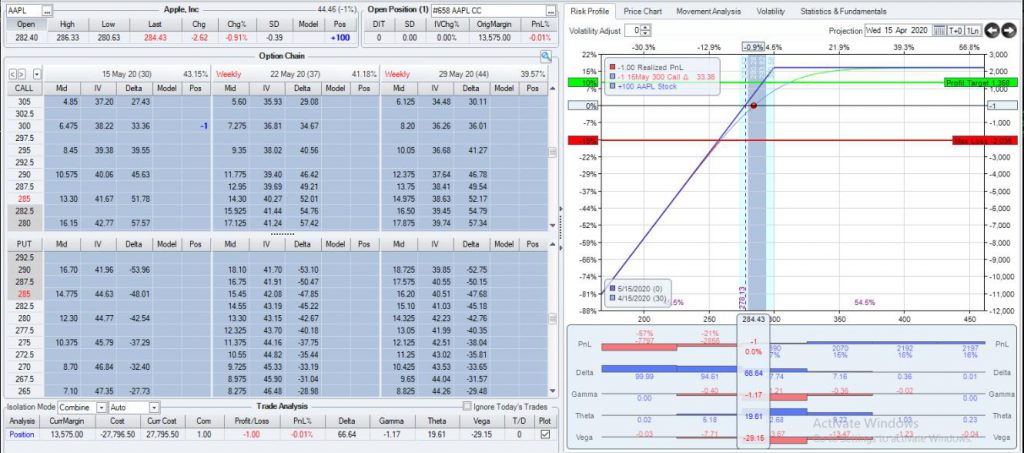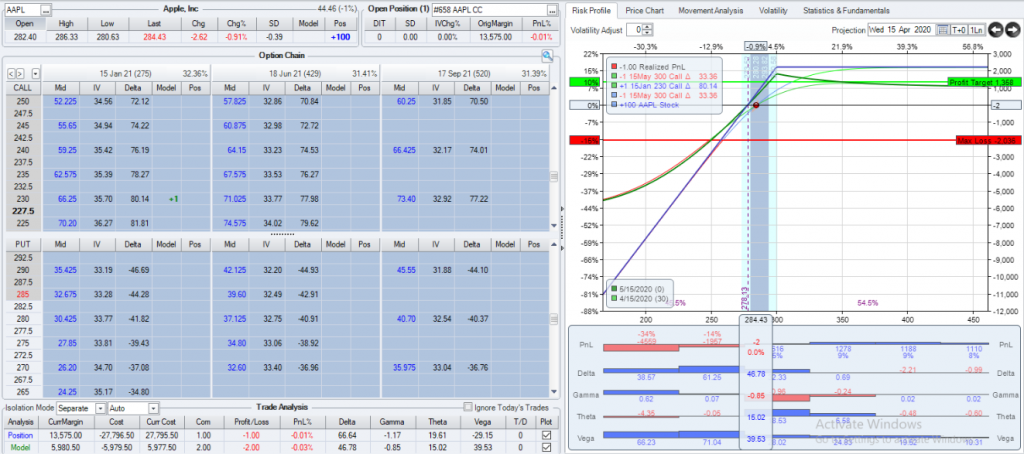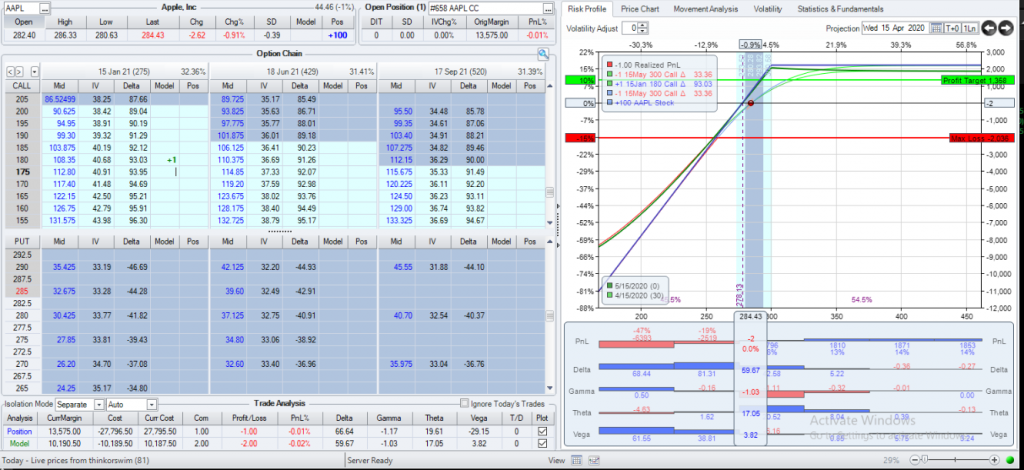Stocks vs Options in a Volatile Market
Originally posted April 15, 2020
At the time of this post, the market has incredibly volatile. Not only has volatility been extremely high, but it has stayed very high for weeks. In a normal market VIX in the 20’s would be considered high. Breaking 30 or 40 happens but it is usually quick and returns to normal. These are not normal times as VIX has been above 30 for about a month and over 60 for about 20 days. If you’ve followed the kind of trades I like to so via my video series “This Week @MidwayTrades”, you will understand that I’ve had to stop trading that way until things return to normal. I’ve been looking for different trades that I can try at a smaller scale while things are crazy. I think this is a good opportunity to show the power of options and how you can do very conservative trades while reducing your risk over stocks.
As with everything I do online, this is for educational purposes only, not trading or financial advice.
Thinking about Risk
Risk is on everyone’s mind right now but, in reality, it should always be on our minds. Managing risk is not just a trading skill but a life skill. But here on MidwayTrades I focus on trading skills. Every trade has risk whether with stocks or with options. With stocks, the primary risk is price, whether you are long or short, you have price risk in the opposite direction. In the world of options, we have more risk factors. Of course we have price risk, but we also have volatility risk, as well as time risk. (I’ll leave aside opportunity cost at this point, but that exists too). In the options world we use the “Greeks” to help describe the various risks to a position. My “Options Fundamentals” series covers these at a high level if you want to better understand them. But there’s a risk that’s ever more basic than the Greeks: How much can I lose in a trade? The most fundamental way to control risk is by knowing and limiting the total risk of a trade. This is done by the strategy deployed as well as the size of the position.
When I tell people I trade options, the first thing many say is “that’s too risky for me, I’ll stick with stocks”. While it is true that trading options can be quite risky, it’s all on how you set them up. I can create a position with options that is nearly identical to the risk of a stock trade for a fraction of the capital risk.
Long Options vs Stock
The simplest option position out there is simply being long a call or a put. This is the equivalent to being long or short a stock for a given amount of time. How equivalent? This is mostly dependent on which option you buy and it’s Delta. Very quickly Delta measures the price risk of an option if the underlying stock moves up 1 point. When you own a stock, your delta is 1. While this is technically impossible to match with an option we can get really close. The more in the money an option is, the more is will act like the stock. So a perfect at the money option will have a delta of .50 which means it will move up $.50 for every $1 the stock moves. As you go further in the money, the delta will increase until you get get 99%+ of the stock’s movement. Of course, the deeper you go in the money, the higher the cost of the contract. Also, the further you go out in time, the more expensive the contract. But this cost is generally still less than the cost of 100 shares of the stock, mostly due to the fact that it is time limited.
For example, let’s take a reasonably high priced stock like AAPL. Apple currently trades at about $284/share. So if I look out to June (65 days), I can get a .80 delta call for about $4,155. That’s a lot of money until you realize that a call represents 100 shares of stock and to own 100 shares of AAPL today would cost about $28,400. So the call is about 15% of the cost of the shares and it should move at about 80% of the stock. That’s not too bad. It also has similar risk on the downside where it will lose .80 for every dollar Apple stock loses. So the risk/reward ratio is much better and, I would argue, makes this a safer trade. If Apple goes to $0, the worst I can lose with my option is $4155, while with the stock I can lose $28,400. That’s a big difference!
Now, nothing is perfect, so if I’m going to pay 85% more for the shares, what am I getting for my money? Two things:
- Time. This option expires in 65 days. At that point, it’s only value is the difference between Apple stock and $250 (the strike price of the call). If Apple doesn’t go up in those 65 days, I can lose money.
- Dividends. Dividends go to owners of stock, not owners of calls. If you like a stock for the dividend, options are not your play.
So while you do give up some advantages of stock ownership, if you look at it from a risk/reward perspective, it may be worth it.
On the bearish side, the risk is not even close. To short a stock like Apple, a broker may require a good deal of margin in the account since the upside risk is unlimited. But if you a bearish on Apple, you can simply buy a put at any strike you wish. Because you long the put, there’s no extra margin worries but you are synthetically short Apple. Just like in the call scenario above, you can pick the strike (delta) and the amount of time, but it is far safer than shorting a high priced stock like AAPL.
Long Diagonals vs Covered Calls
One of the safest options strategies out there is the covered call. If you own 100 shares of a stock, you can sell a call against it to lower you cost basis. If the stock stays under the strike of your short call, you can keep the premium, and can sell another one later if you choose. If the price goes above your strike, you risk having your shares called away at the strike price. This usually only happens at expiration, but there are conditions where it can happen earlier (usually around a large dividend). This is a great strategy and many people use this as their first foray into the world of options (along with just buying a call or put). If done correctly, you can create a small income stream off of stocks you own even if the stock doesn’t pay a dividend. And each time you do this successfully you, essentially, lower the cost basis for your stock.
But as I showed above, owning 100 shares of stock can be expensive vs owning a deep in the money call far out in time. Buying such a call can act as a stock surrogate against which I can sell a call. This strategy is called a long diagonal but doing it in this manner is also sometimes called a “synthetic covered call” or a “poor man’s covered call” because it acts very similarly to a covered call without actually owning the stock. You may see other names for this strategy. Brian Overby of Ally Invest calls this a “Fig Leaf” because you are kind of covered.
So let’s compare these two strategies and compare the risk vs reward. Let’s use AAPL again as I think it shows well as an expensive underlying but this will work with any underlying. So in this example I have a standard covered call in AAPL. I bought 100 shares, and I’m selling a 300 May call against it (a .33 delta).

AAPL Covered Call. Risk: $13,575
This is a typical risk graph for a covered call. The total risk is the price of the 100 shares minus the premium received for the call. In this case that comes to $13,575. Pretty expensive, but AAPL is an expensive stock.
Now let’s compare that to buying a far out deep in the money call and selling the same call against it.

AAPL Diagonal. Risk: $5,980 (.80 delta)
The blue line is the original covered call. The green line is a long diagonal using a January 2021 $230 strike call (.80 delta). As you can see the risk graph is very similar but the total risk is significantly less at just under $6000. Now, the profit potential isn’t quite as good as the covered call, but this is primarily because the stock surrogate is an .80 delta while the stock has a delta of 1. While I think this is a good risk/reward, it’s possible to make the diagonal even closer to the covered call with respect to reward.

AAPL diagonal. Risk $10,190.50 (.93 delta)
In this case I bought a deeper in the money call: $180 strike with a delta of .93. This almost matches the reward of the covered call exactly. However, the risk of this trade is $10,190 which is much closer to the cost of the covered call than the .80 delta. This is why I prefer the risk/reward of the .80 delta, but the risk/reward ratio is really up to each trader.
Back to Risk
So, back to the risk of stocks vs options. In these example I have shown that in terms of real risk (the total amount that can be lost) options, using a conservative strategy and good risk management can be less risky than stock. Of course, there are valid reasons to own stock but I think it’s important, regardless of the vehicle, to understand the risk vs the reward of any trade or investment. Especially in times of market volatility, it’s good to have ways to reduce risk while still getting a good reward and options can be a way to do this.
As usual, I love to hear feedback on all of the content I create. Feel free to reach out here on the site or directly in email at midway@midwaytrades.com. How do you mange risk? Is this a strategy that makes sense? If you have questions, I’ll be glad to address them. I do this so that we can learn from each other.
Until next time …. Good Trading!
This content is free to use and copy with attribution under a creative commons license.